Stable Nitrogen Isotopes as an Effective Tool for Estimating the Nitrogen Demand of Broussonetia papyrifera (L.) Vent Seedlings under Variable Nitrate Concentrations
Abstract
1. Introduction
2. Materials and Methods
2.1. Plant Material and Experimental Treatments
2.2. Measurements of Growth
2.3. Measurement of Chlorophyll Content and Gas Exchange
2.4. Chlorophyll Fluorescence Measurements
2.5. Analysis of Elements and Determination of δ15N in Plants
2.6. Photosynthetic Nitrogen Use Efficiency
2.7. Nitrate Reductase Activity Determination
2.8. The δ15N of the Whole Plant
2.9. The δ15N of N Assimilates in the Whole Plant
2.10. The δ15N of N Assimilates in Plant Organs
2.11. Statistical Analysis
3. Results
3.1. Growth
3.2. Photosynthesis, SPAD, and Chl Fluorescence
3.3. Nitrogen Content in the Leaves, Stems, and Roots of B. papyrifera Seedlings
3.4. Photosynthetic Nitrogen-Use Efficiency (PNUE)
3.5. NRA in the Leaves and Roots
3.6. Nitrogen Isotope Composition in the Leaves, Stems, and Roots of the B. papyrifera Seedlings
3.7. The δ15N Values of N Assimilates in the Whole Plant
3.8. Proportion of Stem N Derived from the Leaves
3.9. The δ15N of N Assimilates in Plant Organs
4. Discussion
5. Conclusions
Author Contributions
Funding
Data Availability Statement
Acknowledgments
Conflicts of Interest
Appendix A
| Parameters | Plant Organs | ||
|---|---|---|---|
| Leaves | Stems | Roots | |
| Dry weight (g) | 0.348 ± 0.031 | 0.075 ± 0.006 | 0.070 ± 0.011 |
| Nitrogen content (%) | 4.53 ± 0.02 | 2.81 ± 0.01 | 3.15 ± 0.01 |
| δ15N (‰) | 7.51 ± 0.09 | 6.97 ± 0.04 | 6.46 ± 0.02 |
References
- Garousi, F.; Shan, Z.J.; Ni, K.; Yang, H.; Shan, J.; Cao, J.H.; Jiang, Z.C.; Yang, J.L.; Zhu, T.B.; Müller, C. Decreased inorganic N supply capacity and turnover in calcareous soil under degraded rubber plantation in the tropical karst region. Geoderma 2021, 381, 114754. [Google Scholar] [CrossRef]
- Tang, Y.Q.; Tian, J.; Li, X.Z.; Yao, M.J.; Wang, S.Q.; Kuzyakov, Y.; Dungait, J.A.J. Higher free-living N2 fixation at rock-soil interfaces than topsoils during vegetation recovery in karst soils. Soil Biol. Biochem. 2021, 159, 108286. [Google Scholar] [CrossRef]
- Cui, J.; Yu, C.; Qiao, N.; Xu, X.; Tian, Y.; Ouyang, H. Plant preference for NH4+ versus NO3− at different growth stages in an alpine agroecosystem. Field Crop. Res. 2017, 201, 192–199. [Google Scholar] [CrossRef]
- Tho, B.T.; Lambertini, C.; Eller, F.; Brix, H.; Sorrell, B.K. Ammonium and nitrate are both suitable inorganic nitrogen forms for the highly productive wetland grass Arundo donax, a candidate species for wetland paludiculture. Ecol. Eng. 2017, 105, 379–386. [Google Scholar] [CrossRef]
- Hessini, K.; Issaoui, K.; Ferchichi, S.; Abdelly, C.; Siddique, K.; Cruz, C. Interactive effects of salinity and nitrogen forms on plant growth, photosynthesis and osmotic adjustment in maize. Plant Physiol. Biochem. 2019, 139, 171–178. [Google Scholar] [CrossRef] [PubMed]
- Hui, N.; Sun, N.X.; Du, H.M.; Umair, M.; Kang, H.Z.; Liu, X.X.; Romantschuk, M.; Liu, C.J. Karst rocky desertification does not erode ectomycorrhizal fungal species richness but alters microbial community structure. Plant Soil 2019, 445, 383–396. [Google Scholar] [CrossRef]
- Wu, Q.X.; Han, G.L.; Tao, F.X.; Yang, T. Chemical composition of rainwater in a karstic agricultural area, Southwest China: The impact of urbanization. Atmos. Res. 2012, 111, 71–78. [Google Scholar] [CrossRef]
- Xia, A.T.; Wu, Y.Y. Joint interactions of carbon and nitrogen metabolism dominated by bicarbonate and nitrogen in Orychophragmus violaceus and Brassica napus under simulated karst habitats. BMC Plant Biol. 2022, 22, 264. [Google Scholar] [CrossRef]
- Wu, Y.Y.; Wu, Y.S. The increase in the karstification-photosynthesis coupled carbon sink and its implication for carbon neutrality. Agronomy 2022, 12, 2147. [Google Scholar] [CrossRef]
- Kalcsits, L.A.; Guy, R.D. Whole-plant and organ-level nitrogen isotope discrimination indicates modification of partitioning of assimilation, fluxes and allocation of nitrogen in knockout lines of Arabidopsis thaliana. Physiol. Plant. 2013, 149, 249–259. [Google Scholar] [CrossRef]
- Kalcsits, L.A.; Buschhaus, H.A.; Guy, R.D. Nitrogen isotope discrimination as an integrated measure of nitrogen fluxes, assimilation and allocation in plants. Physiol. Plant. 2014, 151, 293–304. [Google Scholar] [CrossRef]
- Hu, Y.; Guy, R.D.; Soolanayakanahally, R.Y. Nitrogen isotope discrimination in open-pollinated and hybrid canola suggests indirect selection for enhanced ammonium utilization. Front. Plant Sci. 2022, 13, 1024080. [Google Scholar] [CrossRef] [PubMed]
- Evans, R.D. Physiological mechanisms influencing plant nitrogen isotope composition. Trends Plant Sci. 2001, 6, 121–126. [Google Scholar] [CrossRef] [PubMed]
- Robinson, D. δ15N as an integrator of the nitrogen cycle. Trends Ecol. Evol. 2001, 16, 153–162. [Google Scholar] [CrossRef]
- Hu, Y.; Guy, R.D. Isotopic composition and concentration of total nitrogen and nitrate in xylem sap under near steady-state hydroponics. Plant Cell Environ. 2020, 43, 2112–2123. [Google Scholar] [CrossRef] [PubMed]
- Evans, R.D.; Bloom, A.J.; Sukrapanna, S.S.; Ehleringer, J.R. Nitrogen isotope composition of tomato (Lycopersicon esculentum Mill. cv. T-5) grown under ammonium or nitrate nutrition. Plant Cell Environ. 1996, 19, 1317–1323. [Google Scholar] [CrossRef]
- Mariotti, A.; Mariotti, F.; Champigny, M.L.; Amarger, N.; Moyse, A. Nitrogen isotope fractionation associated with nitrate reductase activity and uptake of NO3- by pearl millet. Plant Physiol. 1982, 69, 880–884. [Google Scholar] [CrossRef]
- Kalcsits, L.A.; Guy, R.D. Quantifying remobilization of pre-existing nitrogen from cuttings to new growth of woody plants using 15N at natural abundance. Plant Methods 2013, 9, 27. [Google Scholar] [CrossRef]
- Hayes, J.M. An Introduction to Isotopic Calculations; Woods Hole Oceanographic Institution: Woods Hole, MA, USA, 2004; pp. 1–10. Available online: https://www.whoi.edu/cms/files/jhayes/2005/9/IsoCalcs30Sept04_5184.pdf (accessed on 25 May 2023).
- Zhang, K.Y.; Wu, Y.Y.; Hang, H.T. Differential contributions of NO3−/NH4+ to nitrogen use in response to a variable inorganic nitrogen supply in plantlets of two Brassicaceae species in vitro. Plant Methods 2019, 15, 86. [Google Scholar] [CrossRef]
- Zhang, K.Y.; Wu, Y.Y.; Su, Y.; Li, H.T. Implication of quantifying nitrate utilization and CO2 assimilation of Brassica napus plantlets in vitro under variable ammonium/nitrate ratios. BMC Plant Biol. 2022, 22, 392. [Google Scholar] [CrossRef]
- Ni, J.W.; Su, S.; Li, H.; Geng, Y.H.; Zhou, H.J.; Feng, Y.Z.; Xu, X.Q. Distinct physiological and transcriptional responses of leaves of paper mulberry (Broussonetia kazinoki × B. papyrifera) under different nitrogen supply levels. Tree Physiol. 2020, 40, 667–682. [Google Scholar] [CrossRef]
- Li, M.; Li, Y.; Li, H.; Wu, G. Overexpression of atnhx5 improves tolerance to both salt and drought stress in Broussonetia papyrifera (L.) vent. Tree Physiol. 2011, 31, 349–357. [Google Scholar] [CrossRef] [PubMed]
- Mei, R.; Wang, Y.; Du, G.; Liu, G.; Zhang, L.; Cheng, Y. Antioxidant lignans from the fruits of Broussonetia papyrifera. J. Nat. Prod. 2009, 72, 621. [Google Scholar] [CrossRef] [PubMed]
- Yao, L.; Yang, H.; Yoo, C.G.; Meng, X.; Li, M.; Pu, Y.; Ragauskas, A.J.; Sykes, R.W. Adsorption of cellobiohydrolases I onto lignin fractions from dilute acid pretreated Broussonetia papyrifera. Bioresour. Technol. 2017, 244, 957–962. [Google Scholar] [CrossRef] [PubMed]
- Peng, X.J.; Liu, H.; Chen, P.L.; Tang, F.; Hu, Y.M.; Wang, F.F.; Pi, Z.; Zhao, M.L.; Chen, N.Z.; Chen, H.; et al. A chromosome-scale genome assembly of paper mulberry (Broussonetia papyrifera) provides new insights into its forage and papermaking usage. Mol. Plant 2019, 12, 661–677. [Google Scholar] [CrossRef] [PubMed]
- Hoagland, D.R.; Arnon, D.I. The water-culture method for growing plants without soil. Circ. Calif. Agric. Exp. Stn. 1950, 347, 32. Available online: https://www.researchgate.net/file.PostFileLoader.html?id=54aefd7ed4c118b6358b45db&assetKey=AS%3A273668901408776%401442259158553 (accessed on 25 May 2023).
- Yousfi, S.; Serret, M.D.; Araus, J.L. Comparative response of δ13C, δ18O and δ15N in durum wheat exposed to salinity at the vegetative and reproductive stages. Plant Cell. Environ. 2013, 36, 1214–1227. [Google Scholar] [CrossRef]
- Poorter, H.; Evans, J.R. Photosynthetic nitrogen-use efficiency of species that differ inherently in specific leaf area. Oecologia 1998, 116, 26–37. [Google Scholar] [CrossRef]
- Suárez, J.C.; Polanía, J.A.; Anzola, J.A.; Contreras, A.T.; Méndez, D.L.; Vanegas, J.I.; Noriega, J.E.; Rodríguez, L.; Urban, M.O.; Beebe, S.; et al. Influence of nitrogen supply on gas exchange, chlorophyll fluorescence and grain yield of breeding lines of common bean evaluated in the Amazon region of Colombia. Acta Physiol. Plant. 2021, 43, 66. [Google Scholar] [CrossRef]
- Taylor, J. Introduction to Error Analysis, the Study of Uncertainties in Physical Measurements; University Science Books: Sausalito, CA, USA, 1997; Available online: https://ui.adsabs.harvard.edu/abs/1997ieas.book.....T/abstract (accessed on 25 May 2023).
- Pritchard, E.S.; Guy, R.D. Nitrogen isotope discrimination in white spruce fed with low concentrations of ammonium and nitrate. Trees 2005, 19, 89–98. [Google Scholar] [CrossRef]
- Kalcsits, L.A.; Min, X.; Guy, R.D. Interspecific variation in leaf-root differences in δ15N among three tree species grown with either nitrate or ammonium. Trees 2015, 29, 1069–1078. [Google Scholar] [CrossRef]
- Buschhaus, H.A. 15N Discrimination as an Indicator of Nitrogen Dynamics in Populus Trichocarpa. Master’s Thesis, University of British Columbia, Vancouver, BC, Canada, 2007; p. 70. [Google Scholar] [CrossRef]
- Yousfi, S.; Serret, M.D.; Araus, J.L. Shoot δ15N gives a better indication than ion concentration or δ13C of genotypic differences in the response of durum wheat to salinity. Funct. Plant Biol. 2009, 36, 144–155. [Google Scholar] [CrossRef] [PubMed]
- Ogaya, R.; Penuelas, J.; Asensio, D.; Llusià, J. Chlorophyll fluorescence responses to temperature and water availability in two co-dominant Mediterranean shrub and tree species in a long-term field experiment simulating climate change. Environ. Exp. Bot. 2011, 71, 123–127. [Google Scholar] [CrossRef]
- Wu, Y.W.; Li, R.; Chen, W.; Liu, X.L.; Kong, F.L.; Ke, Y.P.; Shi, H.C.; Yuan, J.C. Effect of low-nitrogen stress on photosynthesis and chlorophyll fluorescence characteristics of maize cultivars with different low-nitrogen tolerances. J. Integr. Agric. 2019, 18, 1246–1256. [Google Scholar] [CrossRef]
- Campbell, W.H. Nitrate reductase structure, function and regulation: Bridging the gap between biochemistry and physiology. Annu. Rev. Plant Biol. 1999, 50, 277–303. [Google Scholar] [CrossRef] [PubMed]
- Kaiser, W.M.; Huber, S.C. Post-translational regulation of nitrate reductase: Mechanism, physiological relevance and environmental triggers. J. Exp. Bot. 2001, 52, 1981–1989. [Google Scholar] [CrossRef]
- Black, B.L.; Fuchigami, L.H.; Coleman, G.D. Partitioning of nitrate assimilation among leaves, stems and roots of poplar. Tree Physiol. 2002, 22, 717–724. [Google Scholar] [CrossRef]
- Andrews, M.; Morton, J.D.; Lieffering, M.; Bisset, L. The partitioning of nitrate assimilation between root and shoot of a range of temperate cereals and pasture grasses. Ann. Bot. 1992, 70, 271–276. [Google Scholar] [CrossRef]
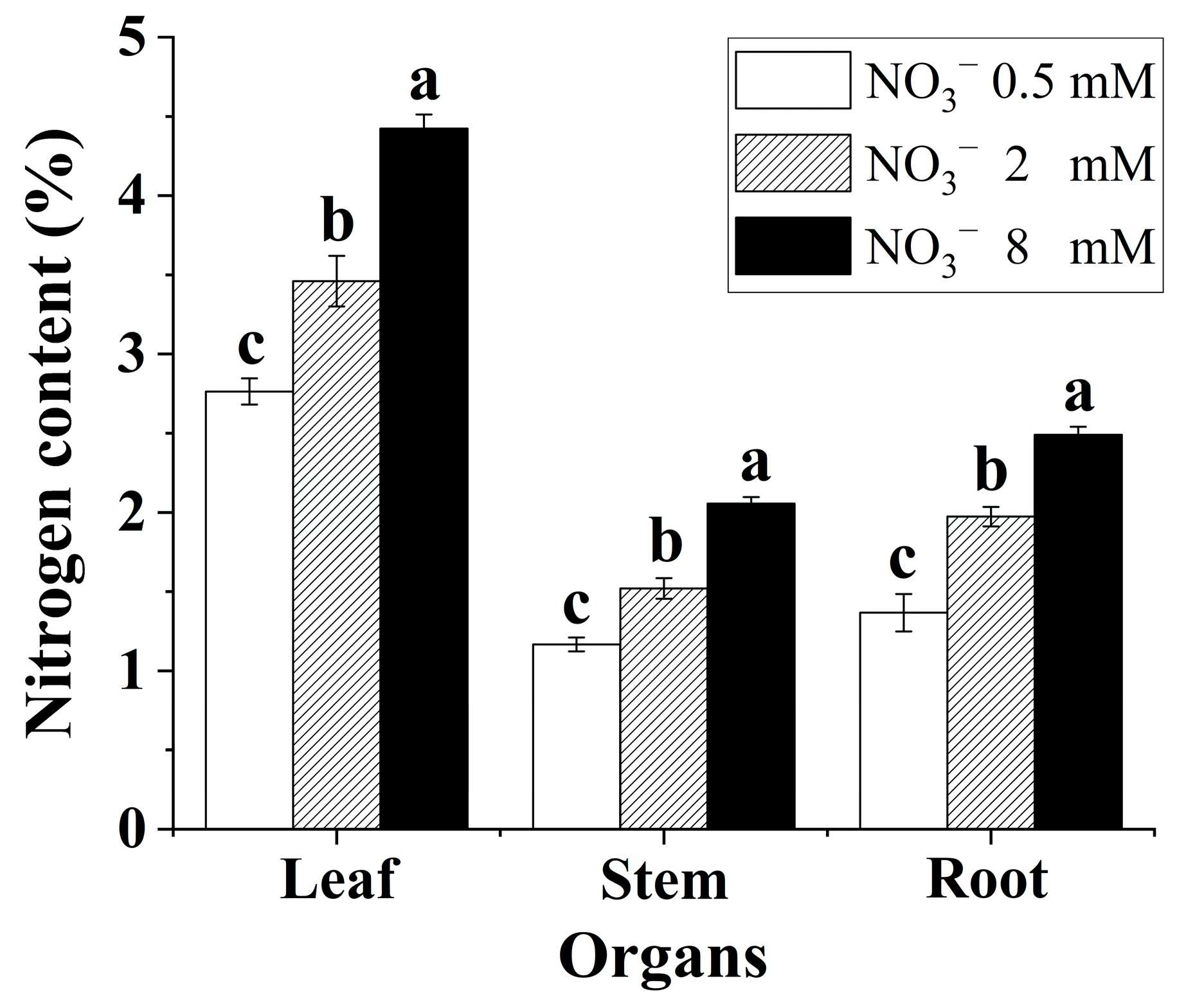
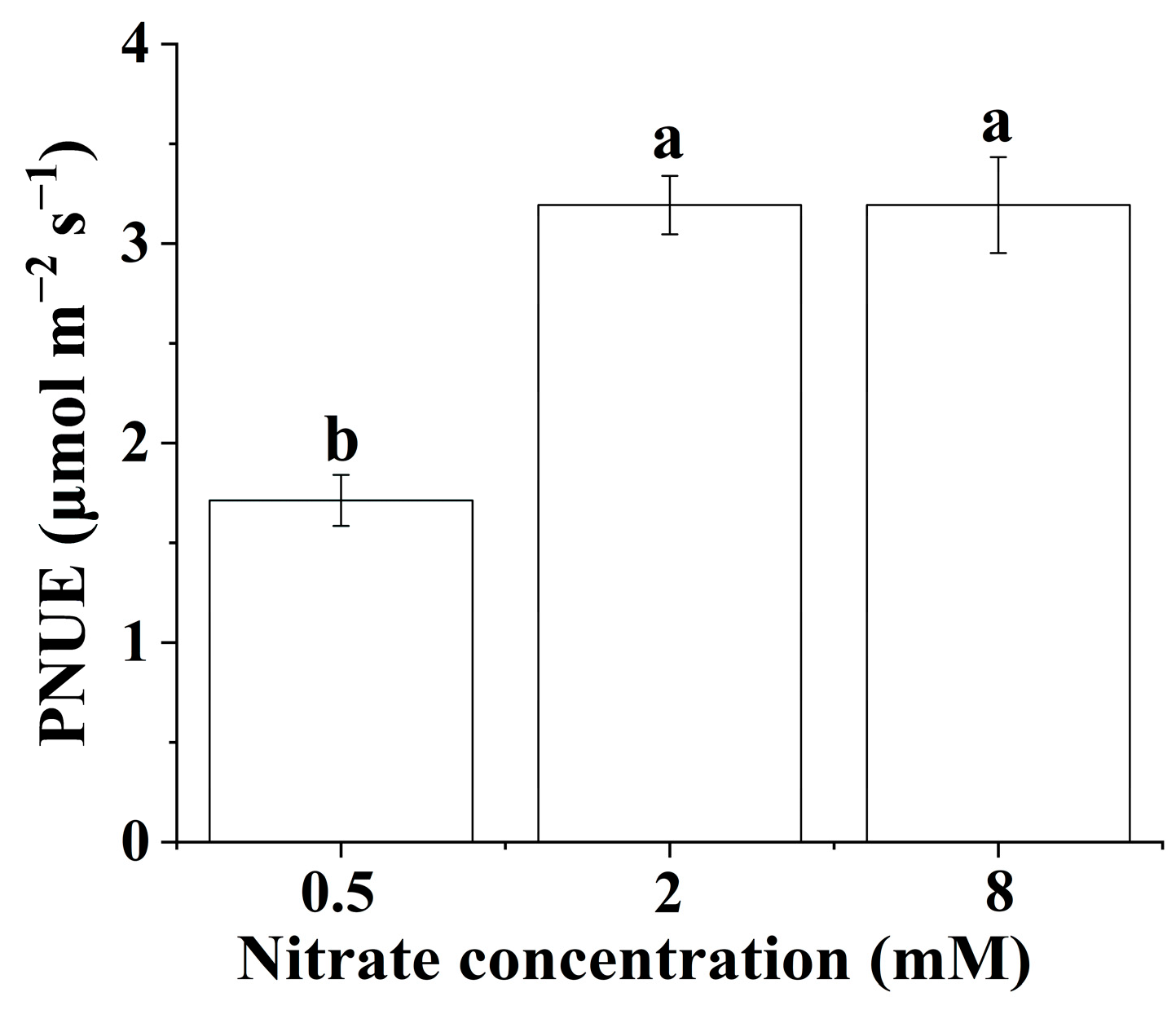
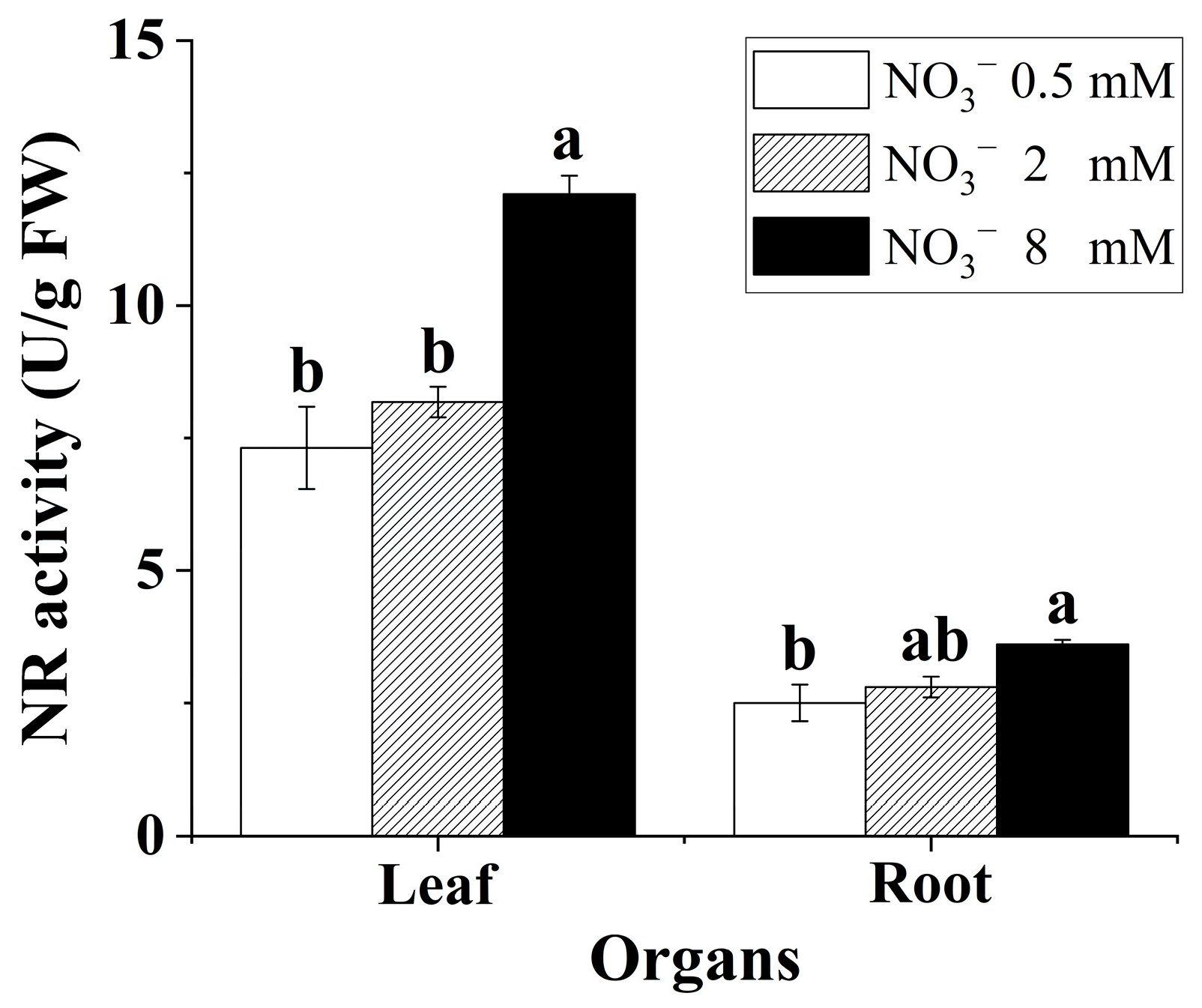
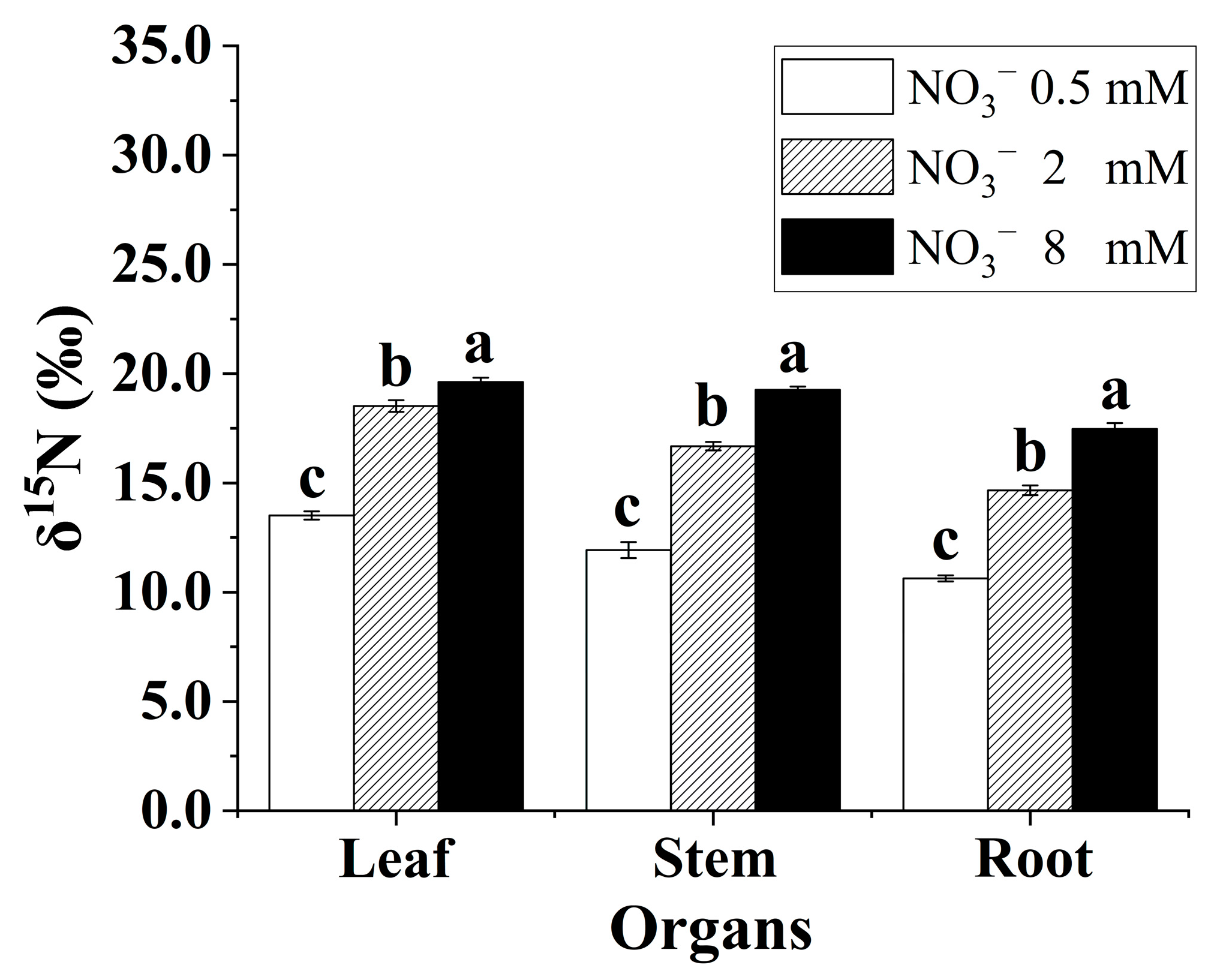

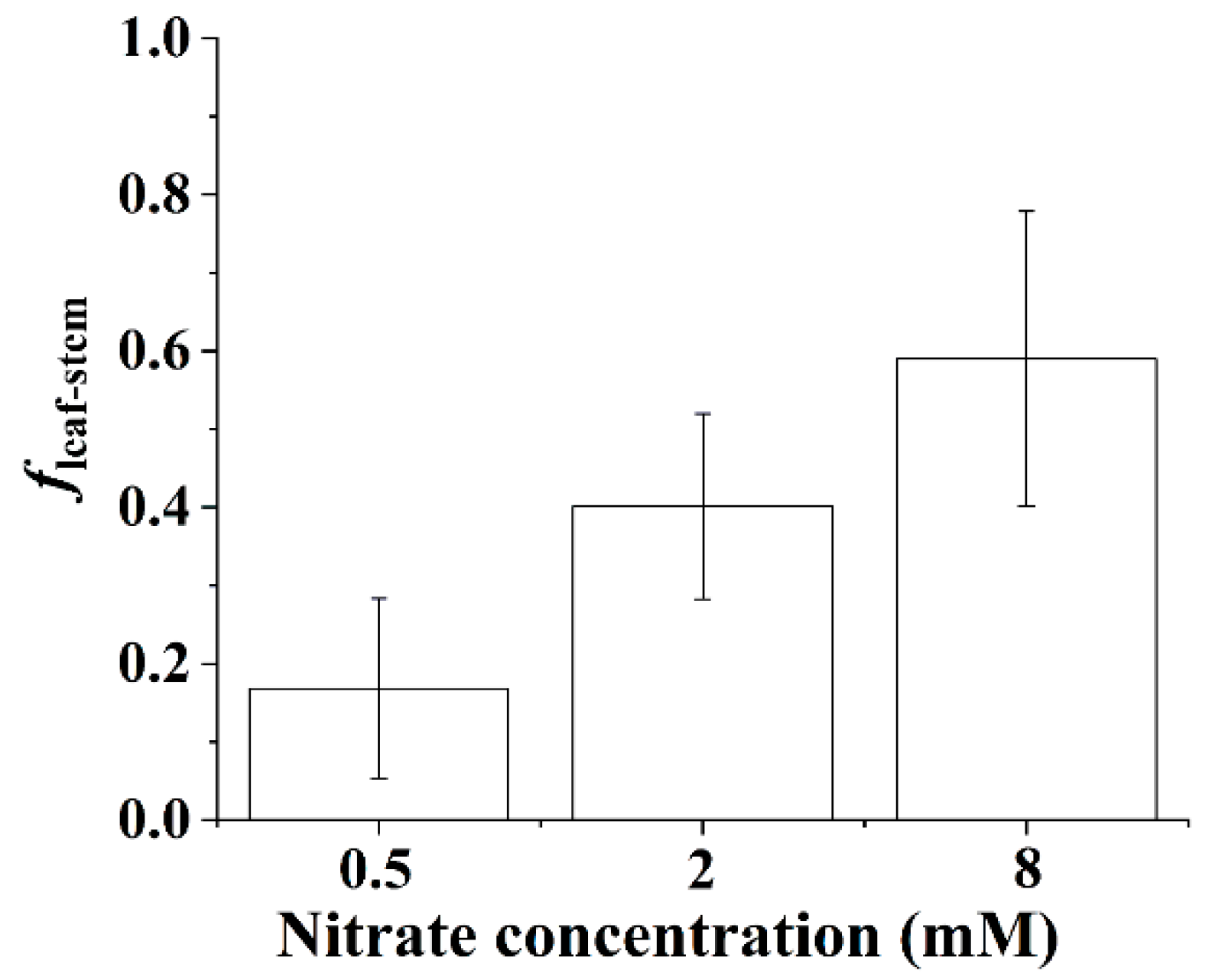
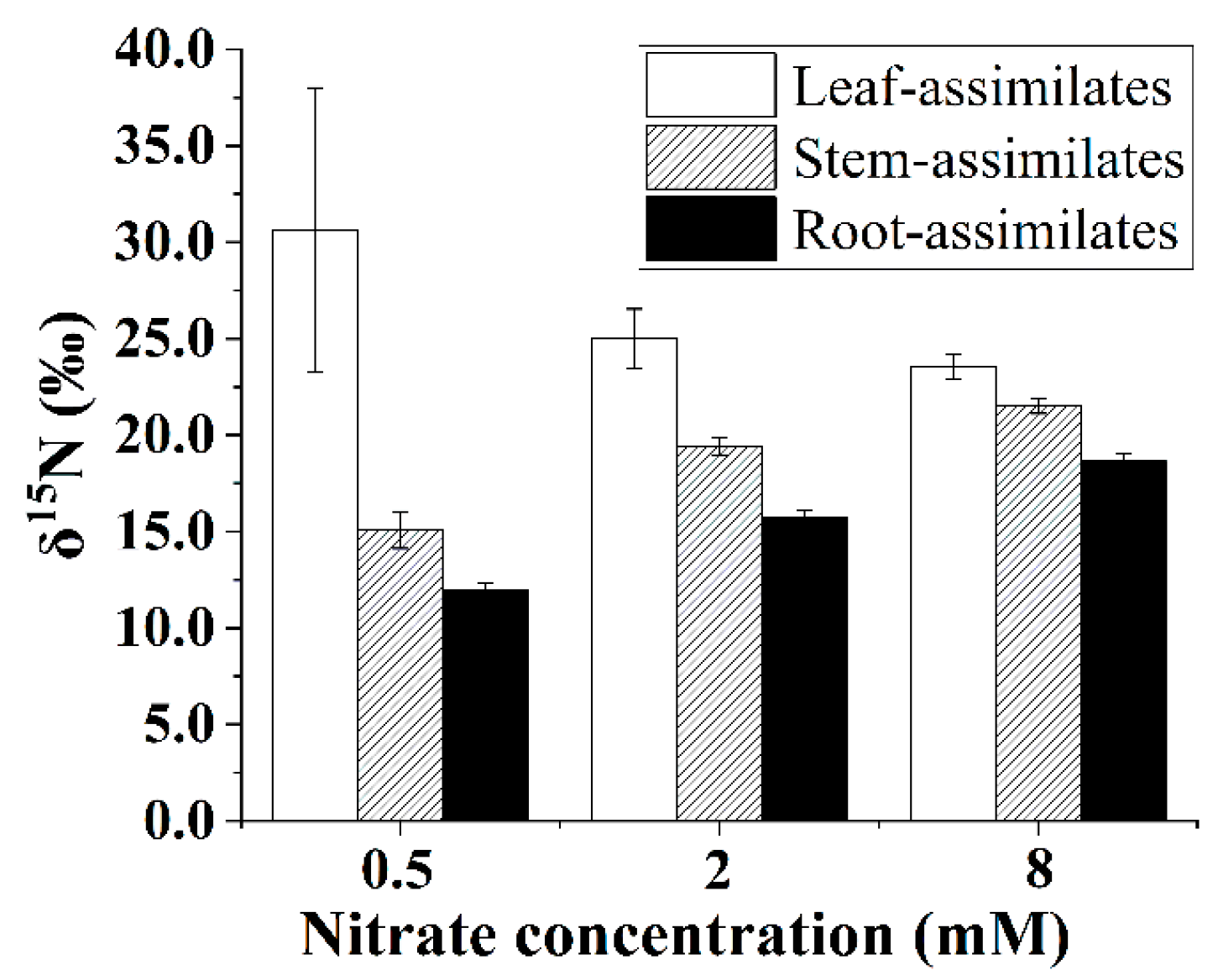
| Parameters | Nitrate Concentration (mM) | ||
|---|---|---|---|
| 0.5 | 2 | 8 | |
| Dry weight (g/plant) | 1.917 ± 0.078 b | 2.814 ± 0.172 a | 3.035 ± 0.112 a |
| Leaf DW (g) | 0.771 ± 0.070 b | 1.224 ± 0.111 ab | 1.460 ± 0.132 a |
| Stem DW (g) | 0.464 ± 0.037 b | 0.622 ± 0.017 ab | 0.653 ± 0.057 a |
| Root DW (g) | 0.683 ± 0.071 a | 0.967 ± 0.102 a | 0.921 ± 0.075 a |
| Shoot length (cm) | 12.8 ± 0.6 b | 16.1 ± 0.9 ab | 17.8 ± 1.2 a |
| Parameters | Nitrate Concentration (mM) | ||
|---|---|---|---|
| 0.5 | 2 | 8 | |
| Pn (μmol m−2 s−1) | 4.714 ± 0.244 c | 11.005 ± 0.189 b | 14.083 ± 0.815 a |
| Gs (mol m−2 s−1) | 0.059 ± 0.012 b | 0.115 ± 0.002 ab | 0.169 ± 0.022 a |
| Tr (mmol m−2 s−1) | 1.067 ± 0.199 b | 2.037 ± 0.034 ab | 2.862 ± 0.334 a |
| Fv/Fm | 0.740 ± 0.010 b | 0.801 ± 0.005 a | 0.819 ± 0.003 a |
| Φp | 0.287 ± 0.009 c | 0.509 ± 0.011 b | 0.623 ± 0.007 a |
| qP | 0.641 ± 0.012 c | 0.802 ± 0.001 b | 0.866 ± 0.005 a |
| qN | 0.788 ± 0.015 a | 0.586 ± 0.024 b | 0.379 ± 0.025 c |
| ETR | 60.477 ± 1.939 c | 107.343 ± 2.305 b | 131.276 ± 1.549 a |
| SPAD | 40.533 ± 1.408 c | 47.367 ± 1.049 b | 57.200 ± 0.436 a |
Disclaimer/Publisher’s Note: The statements, opinions and data contained in all publications are solely those of the individual author(s) and contributor(s) and not of MDPI and/or the editor(s). MDPI and/or the editor(s) disclaim responsibility for any injury to people or property resulting from any ideas, methods, instructions or products referred to in the content. |
© 2023 by the authors. Licensee MDPI, Basel, Switzerland. This article is an open access article distributed under the terms and conditions of the Creative Commons Attribution (CC BY) license (https://creativecommons.org/licenses/by/4.0/).
Share and Cite
Zhang, K.; Zhang, F.; Li, H.; Su, Y.; Wu, Y. Stable Nitrogen Isotopes as an Effective Tool for Estimating the Nitrogen Demand of Broussonetia papyrifera (L.) Vent Seedlings under Variable Nitrate Concentrations. Agronomy 2023, 13, 1663. https://doi.org/10.3390/agronomy13061663
Zhang K, Zhang F, Li H, Su Y, Wu Y. Stable Nitrogen Isotopes as an Effective Tool for Estimating the Nitrogen Demand of Broussonetia papyrifera (L.) Vent Seedlings under Variable Nitrate Concentrations. Agronomy. 2023; 13(6):1663. https://doi.org/10.3390/agronomy13061663
Chicago/Turabian StyleZhang, Kaiyan, Furong Zhang, Haitao Li, Yue Su, and Yanyou Wu. 2023. "Stable Nitrogen Isotopes as an Effective Tool for Estimating the Nitrogen Demand of Broussonetia papyrifera (L.) Vent Seedlings under Variable Nitrate Concentrations" Agronomy 13, no. 6: 1663. https://doi.org/10.3390/agronomy13061663
APA StyleZhang, K., Zhang, F., Li, H., Su, Y., & Wu, Y. (2023). Stable Nitrogen Isotopes as an Effective Tool for Estimating the Nitrogen Demand of Broussonetia papyrifera (L.) Vent Seedlings under Variable Nitrate Concentrations. Agronomy, 13(6), 1663. https://doi.org/10.3390/agronomy13061663






